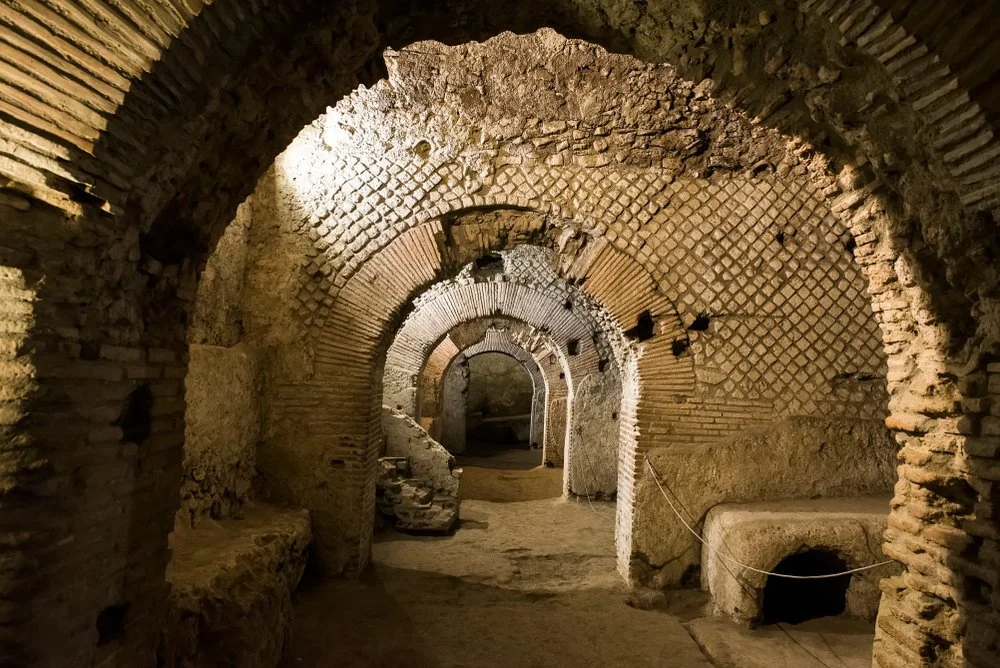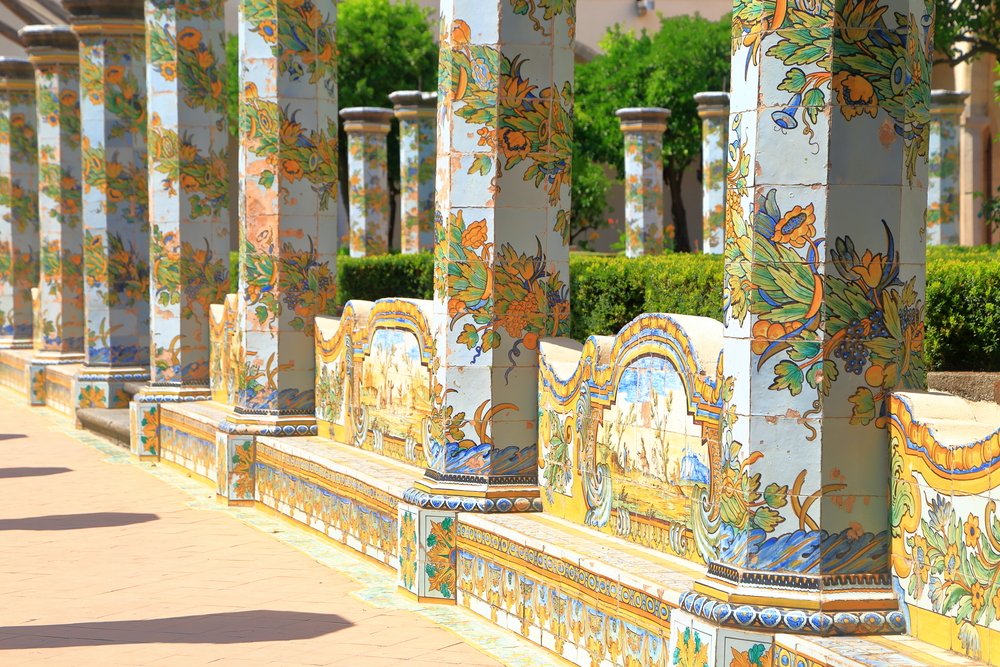Naples
Italy’s forgotten masterpiece
Venice has its gondolas, Florence has Michelangelo’s David, Rome has the Colosseum and Naples…er, pizza?
Despite 3,000 years of history, fine architecture, one of Europe’s greatest art museums, mouth-watering food and a vibrant local culture, many visitors to Italy are put off by Naples’ enigmatic reputation. But Naples is a nuanced and complex city that doesn’t give up its secrets easily, and careful planning and preparation are required to see its best.
In this article we take a closer look at a few of the jewels in the Neapolitan crown…
History made visible on the street
Naples has a remarkable history, stretching back around 3,000 years, when colonists from Greece established trading bases in southern Italy, Magna Graecia. The old city’s narrow, crowded streets still follow a Greek grid, with their decumanus and cardo.
Go beneath the streets and there’s a whole world of ancient stuff – a Roman market square can still be seen under the church of San Lorenzo (pictured below), and the ruins of a Greek temple of Apollo lie near the cathedral.
Naples’ later history is brought to life by the spectacular Renaissance and baroque palaces that line the centro storico. A reminder of a 16th-century Spanish policy that forced feudal lords to have their primary residence in the city, residences such as the fine Palazzo Carafa created a demand for spectacular art and furthered the careers of Caravaggio, Jusepe de Ribera and others. The huge population growth that followed this policy lasted well into the modern era.
Bourbon archaeological collections
You’ll fine Naples’ Greek archaeology at Napoli Sotteranea, a privately-run tour that reveals the extensive infrastructure of the ancient city. And while the Roman city suffered little damage during the 79 CE eruption of Vesuvius, which buried nearby Herculaneum and Pompeii, it became the repository for extraordinary collections of ancient artefacts in the 18th century.
This is due to Charles of Bourbon, an ‘enlightened’ monarch who commenced excavations and took his distinguished guests to Pompeii, to admire dramatic tableaux of skeletons reconstructed for their pleasure. But there was also a new, taxonomic aspect to the Bourbon archaeological interest, as the sheer range of ancient artefacts from these digs testifies.
Exhibited in Naples’ National Archaeological Museum (pictured below), the paintings, mosaics, sculptures and household objects of Pompeii and Herculaneum are still one of the best ways to understand daily life in ancient Rome. They are combined with the Farnese Collection, amassed by Pope Paul III Farnese and transported to Naples by Elisabetta Farnese when she married into the House of Bourbon. Look out for the monumental sculpture of Hercules from the Baths of Caracalla in Rome.
Spectacular art
Like all Italian cities, much of Naples’ art can be enjoyed in situ by visiting the main churches and palaces. Admirers of Caravaggio should head for the Pio Monte della Misericordia, a charitable institution founded in 1602 by seven Neapolitan nobles that preserves his remarkable Seven Acts of Mercy (pictured below). A few streets away, the Sansevero Chapel holds Giuseppe Sanmartino’s Veiled Christ, a sculpture that easily rivals the best works of Michelangelo and Bernini.
Close by is the delightful 14th-century convent of Santa Chiara (pictured below), whose courtyard is decorated entirely in blue and yellow maiolica tiles, a real oasis in the heart of the city. Hand-painted by the ceramists Donato and Giuseppe Massa in the mid-1700s, the tiles, festooned with flowers, vegetables and storytelling scenes, were the exclusive delight of the nuns who lived there in seclusion for nearly 200 years, until monks took their place and opened the grounds to the public in 1925.
The convent of San Martino, perched above Naples, is a fine piece of Baroque architecture in its own right and enjoys unrivalled views towards Capri and the Sorrento peninsula. It holds an amazing collection of presepi, or Christmas nativity scenes. Under the Bourbons this form of folk art reached an astounding apogee, with huge scenes depicting entire Italian villages and, somewhere in the cacophony of seafood and pasta, taverns, dogs, chickens and children, a glimpse of Mary, Joseph and the baby Jesus.
Finally, the Capodimonte art museum (pictured below) contains a painting collection to rival the major galleries of Rome, Florence, Milan and Venice. Unlike these better-known institutions, however, Capodimonte is delightfully uncrowded. Founded by the Bourbon rulers in a vast hunting lodge, its highlights include Renaissance oils by Neapolitan masters, a superb set of Titian portraits (also part of the Farnese dowry) and fine 17th and 18th-century landscapes.
Food and wine
Among Italians, Naples is known as one of the country’s great food destinations, and its simple cuisine focuses on the freshness of the ingredients. Delicious pizzas with local tomatoes and fresh buffalo mozzarella, or seafood from the gulf cooked al cartoccio (wrapped in foil), express such simplicity in ingredients.
The city's traditional dishes, such as spaghetti alle vongole (spaghetti with clams) and eggplant parmigiana, are loved by locals and visitors alike. For those with a sweet tooth, it’s hard to go past a freshly baked sfogliatella, a paste of ricotta cheese, orange and lemon zest wrapped in crisp, flaky pastry.
And it’s a close race for the top coffee spot in Naples — the city is often said to serve the best espresso in Italy — where the local method produces a dense syrup of espresso, served alongside sparkling water to cleanse the palate. Gran Caffè Gambrinus, established in 1860, is the best known of a gaggle of coffee shops at the foot of Via Toledo. A cultural salon under the Bourbon, it stands across from the opera house of San Carlo, and has long been an iconic gathering place for writers, poets, and musicians, becoming a hub for intellectual and artistic discussions.
For wine lovers, it’s best to avoid the more mediocre Lacrima Christi (tears of Christ) and go straight for the excellent Fiano white and Aglianico red varieties. Fiano is primarily grown in the Campania region of southern Italy, particularly around the inland town of Benevento, with the white grapes lent a distinctive character by the area’s volcanic geography. Typically dry and full-bodied, with a vibrant acidity, it pairs well with seafood, poultry, and creamy pasta dishes.
Aglianico is considered one of the oldest and most noble grape varieties in Italy, primarily grown in the regions of Campania and Basilicata, as well as in some parts of Calabria. It is known for producing structured, age-worthy red wines, often dark and deeply coloured. They pair well with grilled meats, hearty stews and aged cheeses.
But overall, there’s really no one thing that makes Naples a compelling destination. Its intoxicating combination of people, history, art and food will delight, creating a true sense of place and authenticity. Yes, there’s noise and an element of chaos… but once you’ve cracked the code of Naples, you’ll fall in love!
Explore Naples in 2024…
On our Puglia to Pompeii tour led by classicist Dr Eireann Marshall this coming February, take the road less travelled through the Italian regions of Puglia and Basilicata, and explore archaeology in depth in the stunning Bay of Naples. Learn more >
Or join archaeologist Dr Estelle Lazer on our new The Bay of Naples tour in April, discovering this extraordinary region with six nights spent in Naples, four nights in the coastal town of Sorrento and two nights on the island of Capri. Learn more >








